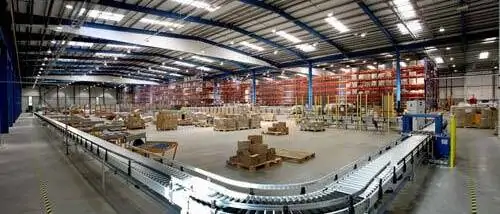Process-oriented warehouse planning takes into account key planning-relevant factors such as product range, storage goods, loading units, and storage types in detail during the conceptual planning stage (planning lead time). Throughout the entire planning process, logistics, construction, and IT aspects must be coordinated with each other in a process-dependent manner. Rough estimates are rarely used.
Process-oriented warehouse planning includes all modules of classic warehouse planning. In contrast to the classic approach, the process-oriented approach also examines process sections such as goods receipt, picking, and goods issue in detail and takes them into account in the overall planning during the aforementioned planning lead time. Process dependency complicates this type of warehouse planning, as even small changes to a process that may seem insignificant can render a prioritized workflow dysfunctional. Nevertheless, modern warehouse planning should always be process-oriented.
Process-oriented warehouse planning in practice
As a rule, all existing or desired logistics processes are documented and examined by means of potential assessments. This also includes process variants that affect the warehouse layout, for example. The most common factors include: number of employees, possible distances, structural conditions, and, of course, the product range. The resulting target processes show, for example, whether logistical aids such as hanging goods, carts, pallets, containers, or mixed cartons are advantageous in certain warehouse sections, or whether a high degree of automation could increase throughput, among other things.
Logistics planners must therefore always consider the overall impact of possible process changes—the respective growth potential, which is inevitably assumed when a process change is made, must be examined, as must the subsequent variability of a warehouse.
Holistic and customer-oriented processes take priority here. The rule is: it is not always necessary to install the most expensive technology, but rather the most effective for the future. This view is particularly important if the client has a smaller budget available. If mathematical algorithms already optimize processes, for example by speeding them up, then such a solution, even if not highly automated, should always be given priority. One example is manual sorting and picking.
Below is an overview of the individual steps involved in such process-oriented warehouse planning and where it is typically used. It does not necessarily have to be projected onto an entire warehouse; individual warehouse sections can also be considered.
Process-oriented warehouse planning Work steps
- Conceptual planning (specifications (“see link to requirement document” – client)
- Process section analyses for goods receipt, etc.
- Detailed planning (requirement document – contractor)
- Project management (client)
- Acceptance of work (client)
Warehouse planning: possible scenarios
- Greenfield planning (new construction)
- Modernization and optimization of existing processes and warehouse technology
- Expansion of existing logistics
The challenges of process-oriented warehouse planning are primarily time-related: Information that reflects the present but also lies far in the future must be taken into account, not least because customers, suppliers, and competitors are constantly setting new requirements. The collected actual data is therefore also subjected to a plausibility check. This serves as a basis for all parties involved for all factors that influence the warehouse.
Important modules of process-oriented warehouse planning
- Storage goods: piece goods, bulk goods; storage aids: pallets, containers
- Loading unit: type, dimensions, weight
- Warehouse system: unit storage, picking warehouse
- Types of storage: floor storage, rack storage
- Rack type: pallet rack, flow rack
- Storage order: fixed or free storage location
- Warehouse organization: storage location management, inventory management, order picking, warehouse management system
- Operation: manual, mechanical, automatic
- Storage and retrieval equipment: forklifts, rail-guided storage and retrieval equipment, work process width
- Safety: safety equipment, fire protection
- Warehouse environment: other trades, facilities
(Source: Heinrich Martin, Transport und Logistik, 8th edition, 2011, page 351)
Comparison criteria include, for example:
- Investment, operating costs
- Storage space costs (pallet/month)
- Handling costs (pallet/month)
- Space and room requirements
- Degree of automation
- Warehouse strategy, warehouse flexibility
- Personnel
- Expansion options
Summary
In practice, process-oriented warehouse planning focuses not only on economic considerations, but also on technical capacities, the possible conveyor system landscape, and the degree of automation. The difficulty here is that the more detailed the individual process steps, such as goods receipt, picking, packing or goods issue, are mapped in the planning stage, the more time-consuming the overall project will be. However, this minimizes potential points of friction.
Further information on warehouse management can also be found under Warehouse functions and Warehouse capacity.
Source teaser image: L’Oreal, Nottingham / CC BY-NC-ND 2.0
